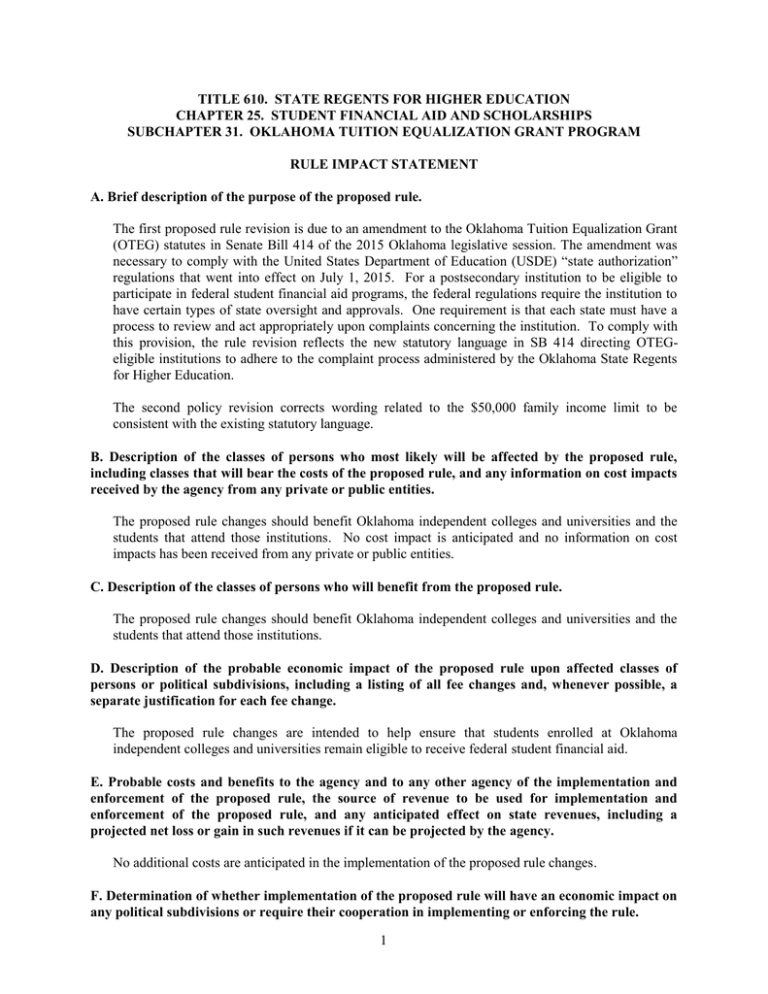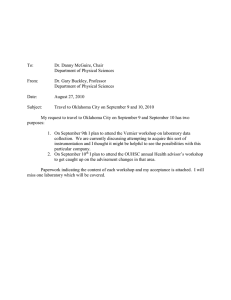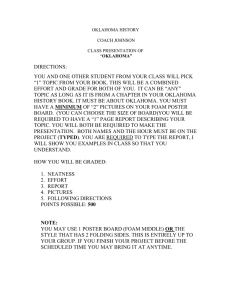Subchapter 31 Rule Impact Statement
advertisement

TITLE 610. STATE REGENTS FOR HIGHER EDUCATION CHAPTER 25. STUDENT FINANCIAL AID AND SCHOLARSHIPS SUBCHAPTER 31. OKLAHOMA TUITION EQUALIZATION GRANT PROGRAM RULE IMPACT STATEMENT A. Brief description of the purpose of the proposed rule. The first proposed rule revision is due to an amendment to the Oklahoma Tuition Equalization Grant (OTEG) statutes in Senate Bill 414 of the 2015 Oklahoma legislative session. The amendment was necessary to comply with the United States Department of Education (USDE) “state authorization” regulations that went into effect on July 1, 2015. For a postsecondary institution to be eligible to participate in federal student financial aid programs, the federal regulations require the institution to have certain types of state oversight and approvals. One requirement is that each state must have a process to review and act appropriately upon complaints concerning the institution. To comply with this provision, the rule revision reflects the new statutory language in SB 414 directing OTEGeligible institutions to adhere to the complaint process administered by the Oklahoma State Regents for Higher Education. The second policy revision corrects wording related to the $50,000 family income limit to be consistent with the existing statutory language. B. Description of the classes of persons who most likely will be affected by the proposed rule, including classes that will bear the costs of the proposed rule, and any information on cost impacts received by the agency from any private or public entities. The proposed rule changes should benefit Oklahoma independent colleges and universities and the students that attend those institutions. No cost impact is anticipated and no information on cost impacts has been received from any private or public entities. C. Description of the classes of persons who will benefit from the proposed rule. The proposed rule changes should benefit Oklahoma independent colleges and universities and the students that attend those institutions. D. Description of the probable economic impact of the proposed rule upon affected classes of persons or political subdivisions, including a listing of all fee changes and, whenever possible, a separate justification for each fee change. The proposed rule changes are intended to help ensure that students enrolled at Oklahoma independent colleges and universities remain eligible to receive federal student financial aid. E. Probable costs and benefits to the agency and to any other agency of the implementation and enforcement of the proposed rule, the source of revenue to be used for implementation and enforcement of the proposed rule, and any anticipated effect on state revenues, including a projected net loss or gain in such revenues if it can be projected by the agency. No additional costs are anticipated in the implementation of the proposed rule changes. F. Determination of whether implementation of the proposed rule will have an economic impact on any political subdivisions or require their cooperation in implementing or enforcing the rule. 1 The proposed rule changes should not have an economic impact on any political subdivisions. G. Determination of whether implementation of the proposed rule will have an adverse economic effect on small business as provided by the Oklahoma Small Business Regulatory Flexibility Act. After consideration with reference to Section 303(A)(4) and 303(B)(6) of Title 75, it is believed that the proposed rules will have no adverse impact upon Small Business. H. Explanation of the measures the agency has taken to minimize compliance costs and a determination of whether there are less costly or non-regulatory methods or less intrusive methods for achieving the purpose of the proposed rule. The proposed changes are designed to minimize compliance costs by working within existing administrative processes of the agency. I. Determination of the effect of the proposed rule on the public health, safety and environment and, if the proposed rule is designed to reduce significant risks to the public health, safety and environment, an explanation of the nature of the risk and to what extent the proposed rule will reduce the risk. The proposed rule should have no effect on the public health, safety, and environment. J. Determination of any detrimental effect on the public health, safety and environment if the proposed rule is not implemented. No effect on the public health, safety, or the environment will result if these rule amendments are not implemented. K. Date the rule impact statement was prepared and if modified, the date modified. October 27, 2015. 2


